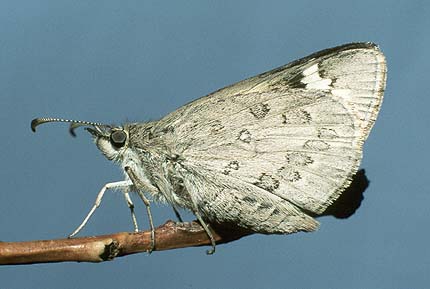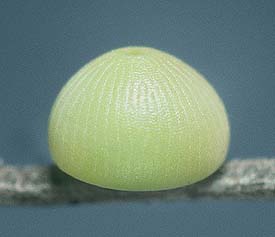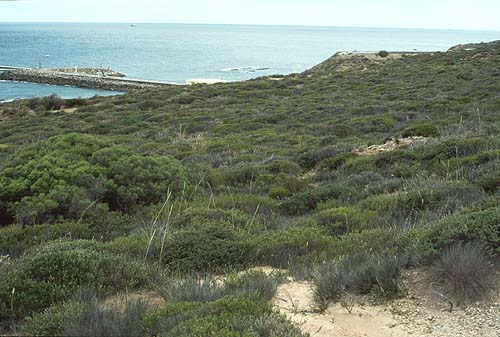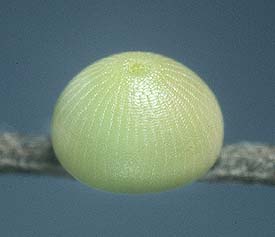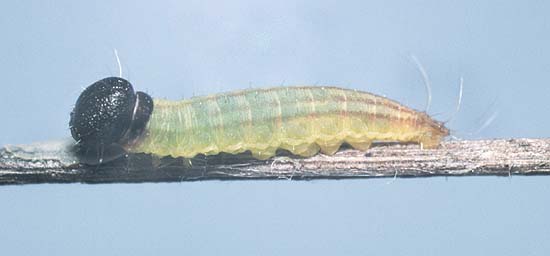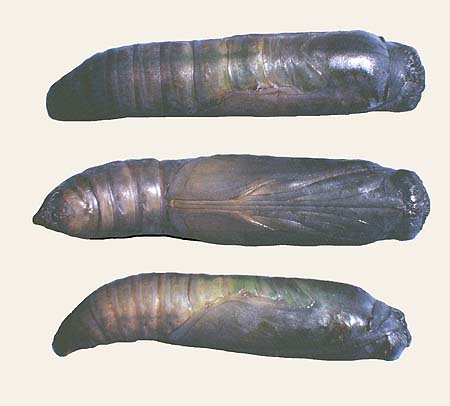-
Larval Food Host
-
Gahnia ancistrophylla (curled saw-sedge),
G. deusta (limestone saw-sedge),
G. hystrix (spiky saw-sedge),
G. lanigera (black grass saw-sedge) (Cyperaceae).
The principal hostplants are Gahnia ancistrophylla and Gahnia lanigera,
but the larvae will sometimes use G. deusta, particularly when it occurs in the
presence of the latter hostplant. The larvae eat the leaves of the hostplants.
Gahnia lanigera is a locally common dryland tussock-like sedge found growing
in limestone based soils. It is low growing to about 30 cm and has tough, wiry,
grass-like needle pointed leaves that have a most unappetising appearance. It is
dark coloured, hence its common name. On Kangaroo Island there occurs
Gahnia hystrix that looks like a dwarf G. lanigera and is even more
unappetizing. It grows in limestone based cliff-top coastal-heath habitats where it
is subjected to constant wind-shear creating a dense pin-cushion like growth. This
plant, unique to Kangaroo Island, is locally used by the skipper.
-
Eggs
-
Large 1.5 mm, pale green, hemi-ellipsoid, base flat, with numerous very indistinct
vertical ribs, numbering about 40-50, and laid singly on the hostplant. The eggs
do not acquire red markings if fertile. The small micropylar area on top of the
egg is depressed. Eggs are usually laid on hostplants situated in full sun.
Females of each population have a preference for egg laying on either living,
green leaves, or dead, black leaves. Larva development within the egg commences
immediately after being laid, and larvae begin to emerge after about 15 days in
late spring. The egg shell is eaten by the larva after its emergence.
-
Larvae
-
The first instar is long cylindrical, initially pale greenish yellow but gradually
turning green after eating the hostplant, with five longitudinal brown coloured
dorsal and subdorsal lines, and with a large shining black slightly rugose head
having a few long hairs, the neck (prothoracic plate) is black, and long recurved
hairs occur posteriorly. After eating the egg shell, the young larva moves off to
the outer parts of the hostplant and makes a small tent-like shelter opening at the
bottom, by silking together the tips of several leaves of the hostplant. The young
larva rests in the shelter during the day with its head pointing downwards towards
the leaf base. It eats at night by feeding on the tips of the leaves.
Subsequent instars gradually acquire a whitish edging to the brown longitudinal lines
and lose the long posterior hairs, the head gradually becomes paler and acquires pale
brown and black frontal markings, and eventually by about the fourth instar acquires the
head pattern described for the final (fifth) instar larva. New shelters are periodically
constructed to fit the growing larvae (each larva makes two or three in its lifetime),
using the leaves of the hostplant, and the internal diameter of the shelters is
approximately the diameter of the larvae. The shelters are constructed in the outer parts
of the hostplant and are teepee tent-like, elongate conical, and always open at the bottom
and are tightly sealed at the top, which typifies this tribe of skippers. These shelters
are elaborate, using many leaves, which are usually silked together in a twisted manner,
and are very strongly lined with silk. Larvae continue to rest and hide from predators
within the shelters during the day with their heads directed downwards, and emerge to eat
briefly at night eating leaves from anywhere on the plant. They grow slowly, and pupation
occurs in the final shelter.
The final instar is long cylindrical shaped, about 25-30 mm long, with the last posterior
segment flattened into the anal plate, smooth, but with the posterior end having some hairs.
The head is large, rugose, elongate, there is an indistinct central longitudinal furrow,
the top is rounded, noticeably hairy with pale coloured hairs that are simple and pointed,
with longer hairs laterally, but those hairs on the front being bent and directed forward.
The body is green, sometimes bluish, with a darker brownish green dorsal line, and a further
two pairs of brown longitudinal subdorsal lines. The area in between the brown lines is
infilled a pale whitish colour. The anal plate and neck are speckled black. The head is pale
brown or greenish brown with a broad black frontal triangular mark tapering dorsally, the
mouthparts are black, and there is usually a broad black side stripe that does not reach the
apex of the head, but this stripe may be absent or only partly developed. The body, and
particularly the anal plate on the last segment, have some tiny secondary setae that are
elongate vase shaped with convex tops, and which are set on simple smooth raised bases that
are black coloured on the anal plate but transparent on the body. Near pupation the larvae
turn pale semi-translucent green and have a dark longitudinal dorsal line.
The presence of larvae on the principal hostplants is discernible by the characteristic,
elongated tent-like shelters opening at the bottom, that occur in the outer parts of the
plants. There is usually only one shelter on a single hostplant. This characteristic shelter
can be used during field surveys to differentiate A. atralba from Hesperilla
species that may also be using the same Gahnia hostplants, particularly in the case
of Gahnia ancistrophylla and G. deusta. The shelters of Hesperilla
species open at the top.
Gahnia hystrix, having a dense, pin cushion like growth presents an unusual set of
needs for the larvae. In this instance, the larvae utilise any gap in the structure of
the pin-cushion to make their shelters, but fully grown larvae require almost the entire
depth of the plant, such that the shelter opening occurs at the bottom edge of the pin
cushion, and the larvae then have to make their way around to the edge or top of the plant
to feed at night.
-
Pupae
-
Short cylindrical, about 16-23 mm long, dark brown or dark brown and green with the
abdominal area being green, nearly smooth without abdominal bristles. The posterior
end tapers to a short, narrow, bluntly ended, dark brown cremaster. The head is
rounded, with the head cap (operculum) being black and brown coloured, having a
characteristic rounded shape, and there are some short hairs. The central part of
the operculum is black coloured, heavily sclerotised (very rugose) and is divided
into a larger ventral part (which is sometimes further divided into two lateral parts),
and two smaller equal-sized dorsal parts. The relative size of these segments varies
from region to region. There are further, smaller less sclerotised brown coloured areas
lateral to the central part.
Pupation normally occurs in the final larval shelter on the hostplant, and the larva
pupates head downwards towards the leaf base. The pupa is secured within the silk
lined shelter by very strong hooked bristles emanating from the end of the cremaster.
During pupation a large blob of black liquid is left on the operculum or in the entrance
of the shelter, and the reason for this is not known, but the liquid could be a deterrent
to small predators while the pupa is still soft. The pupa duration is about 24-36 days in
spring, decreasing as the weather gets warmer. The empty pupa case remains inside the shelter
after the adult skipper emerges, and is either brown or dark brown coloured. The emergence
of the adult skipper from the pupa is aided by rain or heavy overnight dew, and in some
instances unless the pupa gets wetted near this point in time the skipper will emerge deformed.
-
Flight Period in South Australia
-
The skipper has spring and autumn flights based on two distinct broods that each usually
last one year, i.e. eggs laid in spring or autumn will respectively produce an adult flight
during the following spring or autumn, for brood periods of 12 months. However, the gene
pool continues to mix, as in captivity it is known that during good summer seasons some of
the spring larvae may develop quicker to produce adults during the autumn flight. Adults
start to emerge earlier in the spring on the West Coast than for southern areas. The skipper
overwinters as larvae.

-
Distribution
-
The skipper usually occurs wherever its principal hostplants grow in adequate density,
and that includes most of the southern agricultural belt, and also Kangaroo Island.
It is also known to occur in mallee habitat in adjacent areas of Victoria.
A morphologically very similar skipper Antipodia dactyliota, presently treated
as a distinct species, occurs in southwest WA.
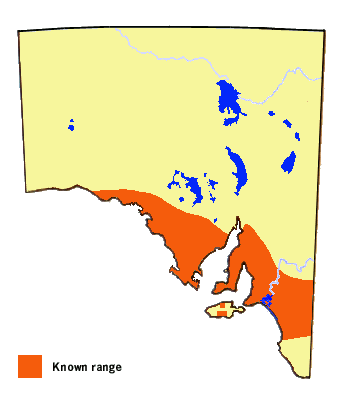
-
Habitat
-
The skipper will occur wherever its principal hostplants are growing, which includes
limestone based open mallee or coastal cliff-heath habitat for Gahnia lanigera
(and this habitat is also used by the minor hostplants G. deusta and G. hystrix),
and higher rainfall sand-based moist open woodland habitat for Gahnia ancistrophylla.
The skipper is still maintaining a precarious presence along the coastal cliff-heaths south of
Adelaide, and at one historical point in time these areas were the only localities known in
South Australia where the skipper could be found.
-
Conservation Status in South Australia
-
The skipper is widespread in distribution but is rarely seen in flight, and on that basis
is considered to be rare. However, its early stages are more frequently seen, and are often
the only means to determine the skippers' presence in an area. It is maintaining a stable
presence in the large mallee dominated conservation parks.
-
Threats
-
The main threats are from bushfires, and the effects of agricultural and urban disturbances.
Much of its habitat is now fragmented and the skipper has been unable to recolonise many of
these areas after bushfires or degradation. These small fragmented areas also make colonies
vulnerable to attack from wasp parasitoids, diseases and virus, and it is often this group
of predators that terminate such remaining colonies weakened by inbreeding. Populations near
large urban areas are in a steady decline. Habitat adjacent to farming areas is susceptible
to toxic spray drift, especially when it is applied by aerial means.
-
Conservation Strategy
-
Remaining areas of remnant coastal cliff-heath habitat, particularly along the exposed
cliff edges south of Adelaide need to be conserved (such as Port Stanvac), and its
G. lanigera hostplants included in revegetation projects in these areas.
However, it may be too late to stabilise these populations as they now appear to be in
irreversible decline.
